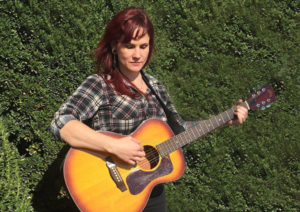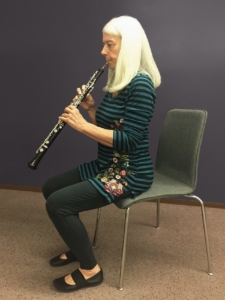 If you play a musical instrument—including your own voice—you probably know that practicing can take a toll on your body. But practicing is the heart of the matter. You can’t get to that inspiring state of feeling the music flow through you and out your instrument—a sort of musical Samadhi—without a foundation of lots of practice. Every musician knows that this state represents thousands of hours of wood-shedding.
If you play a musical instrument—including your own voice—you probably know that practicing can take a toll on your body. But practicing is the heart of the matter. You can’t get to that inspiring state of feeling the music flow through you and out your instrument—a sort of musical Samadhi—without a foundation of lots of practice. Every musician knows that this state represents thousands of hours of wood-shedding.
All that practice can be hard on your body. Each instrument has its unique ergonomic quirks. Violinists and violists often experience neck and shoulder pain. Same for flutists. Other woodwind players often have problems with the right thumb, the one that bears most of the weight of the instrument—as an oboe/English horn player I can attest to this! People who play bluegrass or rock-type instruments such as guitar, banjo and mandolin, often develop a slumped-shoulder position, leading to neck and shoulder pain.
We may not be able to avoid completely all these individual issues. But we can incorporate healthy postural practice into our copious practice time, so that the basic structure of our bodies is supported and we can breathe freely.
Free breathing is important not only for singers and wind players. How we breathe impacts how any musician phrases the music they play or sing. And phrasing is the difference between playing notes and making music.
Here are some suggestions for incorporating healthy posture into your practice:
 If you sit to practice, sit toward the front of your chair. Tilt the top of your pelvis slightly forward, so that your sacrum is at about a 30-degree angle. This will allow your spine to maintain its natural curves. When the spine is able to hold itself up in this way, you don’t need to contract your abdominals to keep you upright. This makes breathing a whole lot easier, because our abdominals are some of our primary respiratory muscles. Free breathing depends on these muscles being able to expand and contract fully. The other benefit I’ve noticed from sitting this way is that my concentration is much sharper than if I slump back.
If you sit to practice, sit toward the front of your chair. Tilt the top of your pelvis slightly forward, so that your sacrum is at about a 30-degree angle. This will allow your spine to maintain its natural curves. When the spine is able to hold itself up in this way, you don’t need to contract your abdominals to keep you upright. This makes breathing a whole lot easier, because our abdominals are some of our primary respiratory muscles. Free breathing depends on these muscles being able to expand and contract fully. The other benefit I’ve noticed from sitting this way is that my concentration is much sharper than if I slump back.- If you stand to practice, the same concept holds true. Stand with your pelvis tilting forward (cow tilt as opposed to cat tilt) so that your sacrum is at a 30-degree angle.
- Either sitting or standing, slide your shoulder blades down your back, lifting your heart. This keeps your head and neck in a healthy position.
- Ground yourself. Notice if you have a tendency to either slump in your chair, or to prop yourself up as if you’re fighting gravity. Years ago I learned a concept called “active yield” from Donna Farhi. Here’s how to practice it: Sit in a chair as I described in the first bullet point. Now press your pelvic floor and ischial tuberosities (aka the “sit bones”) into your chair. Notice if you feel your upper body lifting a bit, like a rebound. If the rebound occurs, you are practicing active yield. If not, adjust your posture and try again. Active yield will only happen when your spine is in integrity. You can also do active yield while standing with your feet hips-width apart. Practicing active yield has been helpful for me when I feel nervous about a solo in the orchestra. There’s nothing that messes with my breathing, and my phrasing, more than stage fright. Grounding my body through active yield is essential.
- If you find your hands sore or fatigued during or after a practice session, try some of these hand exercises.
- Practice yoga (you knew this was coming, didn’t you?). Especially when you sit for long periods of practice or rehearsal, it can be refreshing to stand up and stretch. Try something simple, such as Palm Tree Pose (Talasana) or Wall Dog Pose. Practicing a seated twist every once in a while while in your practice chair is also a great way to shake off the stagnation that comes from sitting.
Of course, if you play in a band onstage, you likely move around a bit. That’s fine. Don’t worry so much about perfect posture while you’re on stage. Your job onstage is to communicate with your audience. Moving freely, even if it means moving out of bounds posture-wise, is one of the ways a musician connects with his/her audience. Since practice is where we spend most of our time, it’s more important to practice healthy posture then. It’s quite possible that the healthy posture we practice at home will show up on stage later on.
What are your favorite yoga poses that help with practice fatigue?
